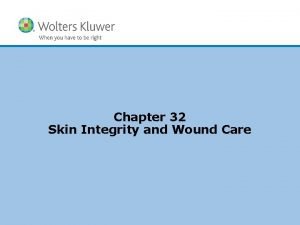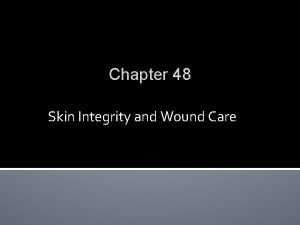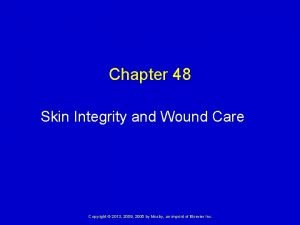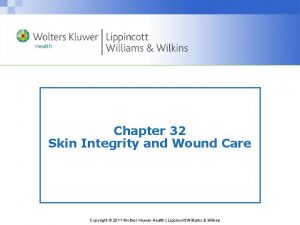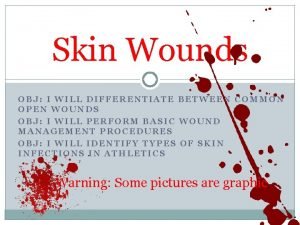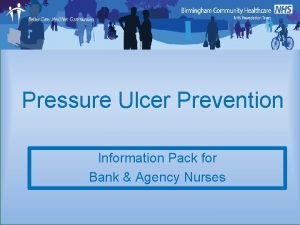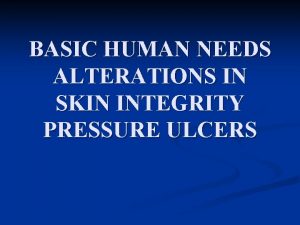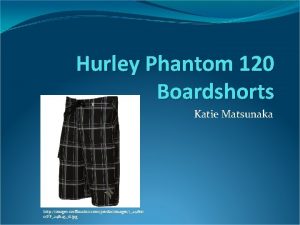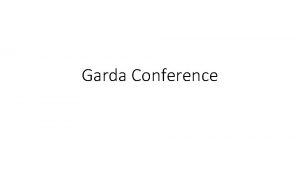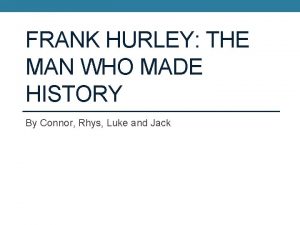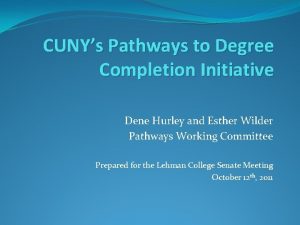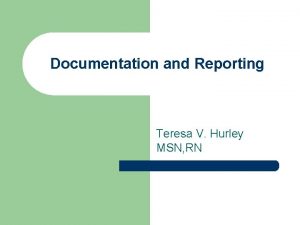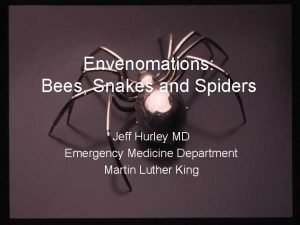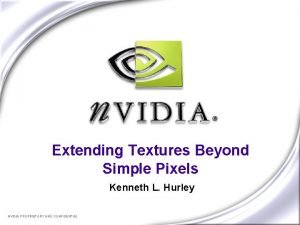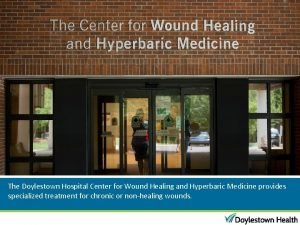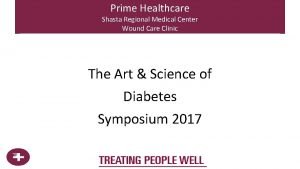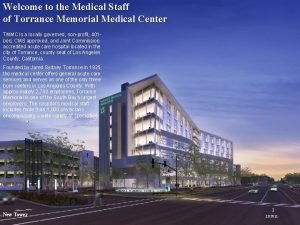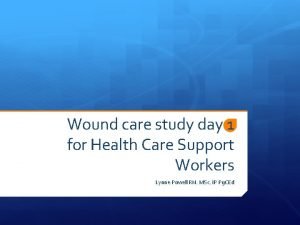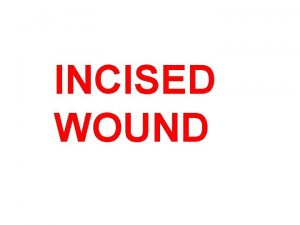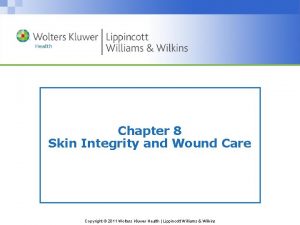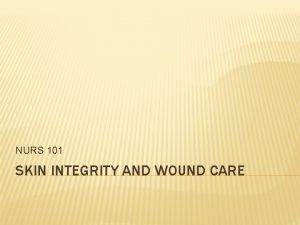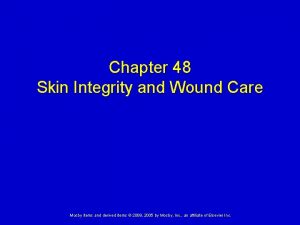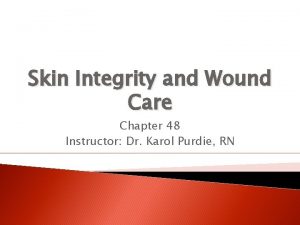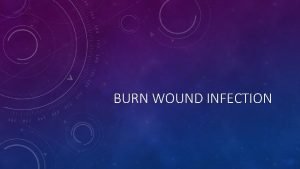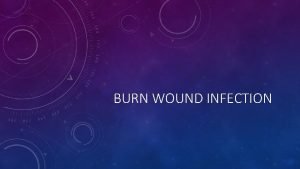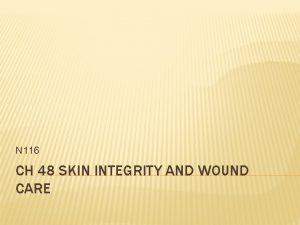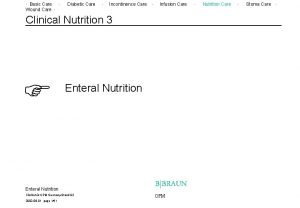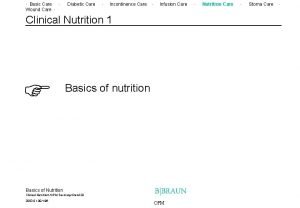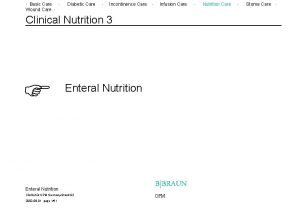Skin Integrity and Wound Care Teresa V Hurley


























- Slides: 26

Skin Integrity and Wound Care Teresa V. Hurley, MSN, RN

Skin Integrity • Largest organ in the body • Functions – First line of defense against microorganisms – Regulation of body temperature – Transmits sensations of pain, temperature, touch and pressure --Vitamin D production and absorption --secretes sebum

Wounds • What are wounds ? – Break in skin or mucous membranes

Wound Classification • Superficial • Deep (blood vessels, nerves, muscle, tendons, ligaments, bones) • Open Wound – Superficial or deep break in skin (abrasion, puncture, laceration)

Wound Classification • Closed: blunt force; twisting, turning, straining, bone fracture, visceral organ tear • Acute: trauma sharp object or blow – Surgical incision, gun shot, venipuncture • Chronic: pressure ulcers • Causality – Intentional: surgical incision – Unintentional: traumatic • Knife • Burn

Pressure Wounds • Damage to tissues due to pressure • Factors – Immobility – Elderly – Skin moisture – Malnutrition (protein) – Shearing Forces – Friction – Risk Factors as outlined on Braden Scale

Pressure Ulcer Stages • Stage I: No Skin Break – Skin temperature, consistency (firm), sensation (pain or itching) – Persistent redness in light skin tones – Persistent red, blue or purple hue in darker skin tones

Pressure Ulcer Stages • Stage II: Superficial – Partial-thickness skin loss (epidermis and/or dermis – Abrasion, blister or shallow crater • Stage III – Full-thickness skin loss (subcutaneous damage or necrosis and may extend down to but not through fascia – Deep crater

Pressure Ulcer Stages • Stage IV: full thickness skin loss and destruction, necrosis of the tissue, damage to muscle, bone, tendons and joint capsules and sinus tract • Types of Dressings • • Transparent film (Tegraderm, Bioclusive) Hydrocolloid (Duoderm, Comfeel) Hydrogel Gauze Roll (Kerlix) – Provide moist environment – Loosen slough and necrotic tissue – Wick drainage from wound

Pressure Ulcer Assessment • Tissue Type – Granulation Tissue: red and moist – Slough: yellow stringy tissue attached to wound bed; removal essential for healing – Eschar: necrotic tissue which is brown or black appearance must be debrided

Pressure Ulcer Assessment • Wound Dimensions (L, W, D) • Wound Deterioration – Skin surrounding ulcer • Redness, warmth, edema • Exudate – Amount, color, consistency, odor

Wound Healing • Primary Intention – skin edges are approximated (closed) as in a surgical wound – Inflammation subsides within 24 hours (redness, warmth, edema) – Resurfaces within 4 to 7 days • Secondary Intention: tissue loss – Burn, pressure ulcer, severe lasceration – Wound left open – Scar tissue forms

Wound Healing • Inflammatory Response – Serum and RBC’s form fibrin network – Increases blood flow with scab forming in 3 to 5 days • Proliferative Phase: 3 -24 days – Granulation tissue fills wound – Resurfacing by epithelialization • Remodeling: more than 1 year – collagen scar reorganizes and increases in strength – Fewer melanocytes (pigment), lighter color

Some Factors Influencing Wound Healing • Age • Nutrition: protein and Vitamin C intake • Obesity decreased blood flow and increased risk for infection • Tissue contamination: pathogens compete with cells for oxygen and nutrition • Hemorrhage • Infection: purulent discharge • Dehiscence: skin and tissue separate • Evisceration: protrusion of visceral organs • Fistula: abnormal passage through two organs or to outside of body

Therapeutic Modalities • Contingent on location, size, wound type, exudate, infection, dressed or undressed • Assessment – Inspect and palpate surrounding area – Wound edge approximation (healing ridge noted) – Presence and characteristics of drainage • • • Serous Sanguineous Serosanguineous Purulent Consistency, odor and amount

Wound Assessment • Wound Closure – Staples – Sutures – Steri-strips • Drains – Penrose – Hemovac or Jackson Pratt exert low pressure

Some Dressing Types and Assistive Devices • • Dry Dressings Wet-to-Dry Dressings Packing Wound Vacuum Assisted Closure: apply local negative pressure to draw wound edges together; healing acclerated with the formation of granulation, collagen etc. to close wound or prepare for skin grafting • Electrical Stimulation • Abdominal Binders • Montgomery Straps

Heat and Cold Therapies • Heat – Vasodilation • • Increases blood flow Nutrient delivery Removal of waste Decreases venous congestion – Blood Viscosity Decreased • leuokocytes • antibiotics

Heat and Cold Applications • Heat – Muscle relaxation with decrease in pain from spasm and stiffness – Tissue Metabolism increased with increased warmth and blood flow – Increased capillary permeability promotes nutrient delivery and waste removal

Cold Applications • Vasoconstriction – Reduce blood flow preventing edema formation and decreases inflammation – Local anesthesia – Cell metabolism decreased with o 2 demands decreased – Increased blood viscosity promotes coagulation – Pain relief with decrease in muscle tension – Direct Trauma; superficial lacerations, arthritis

Complications • Heat application leads to reflex vasoconstriction within 1 hour – Complications • Epithelial cells damaged • Redness, tenderness, blistering

Complications • Cold – Reflex vasodilation • • • Tissue ischemia Skin redness Bluish purple mottling Numbness Burning pain Tissues may freeze

Modalities • MD order: body site, type, frequency and duration of application • Moist or dry • Warm/Cold Compresses • Warm Soaks (relaxation, debride wounds) • Sitz Baths (rectal or vaginal surgery, hemorrhoids, episiotomy) • Aquathermia pads (muscle sprains, inflammation or edema) • Commerical Hot and Cold Packs

Contraindications • Heat – Site with active bleeding – Acute localized pain (appendicitis) leads to rupture – Cardiovascular (vasodilation to large areas leads to decrease blood supply to vital organs

Contraindications • Cold – Site pre-existing edema prevents absorption of intersitial fluid – Neuropathy (unable to sense) – Shivering will intensify with acute elevations in temperature

Critical Thinking • What other factors need to be assessed before application of heat and cold therapies? • Circulatory? • LOC? • Sensory?
 Serosanguineous vs serous
Serosanguineous vs serous Chapter 48 skin integrity and wound care
Chapter 48 skin integrity and wound care Copyright
Copyright Chapter 48 skin integrity and wound care
Chapter 48 skin integrity and wound care Skin wound
Skin wound Thick skin and thin skin
Thick skin and thin skin Skin integrity assessment
Skin integrity assessment Sskin bundle
Sskin bundle Anatomical location
Anatomical location Altered skin integrity
Altered skin integrity Hurley phantom 120
Hurley phantom 120 Siobhan hurley
Siobhan hurley Kirsten hurley
Kirsten hurley Frank hurley: the man who made history
Frank hurley: the man who made history Dene hurley
Dene hurley Tape v hurley
Tape v hurley Dr. jeffrey hurley
Dr. jeffrey hurley Kevin prin
Kevin prin Lynda hurley
Lynda hurley Cubemap generator
Cubemap generator Thin skin vs thick skin
Thin skin vs thick skin Steps to a basic facial milady
Steps to a basic facial milady Ryb color code wound care
Ryb color code wound care Doylestown hospital wound care center
Doylestown hospital wound care center Shasta regional wound care
Shasta regional wound care Aileen takahashi md torrance ca
Aileen takahashi md torrance ca Transient contact
Transient contact
